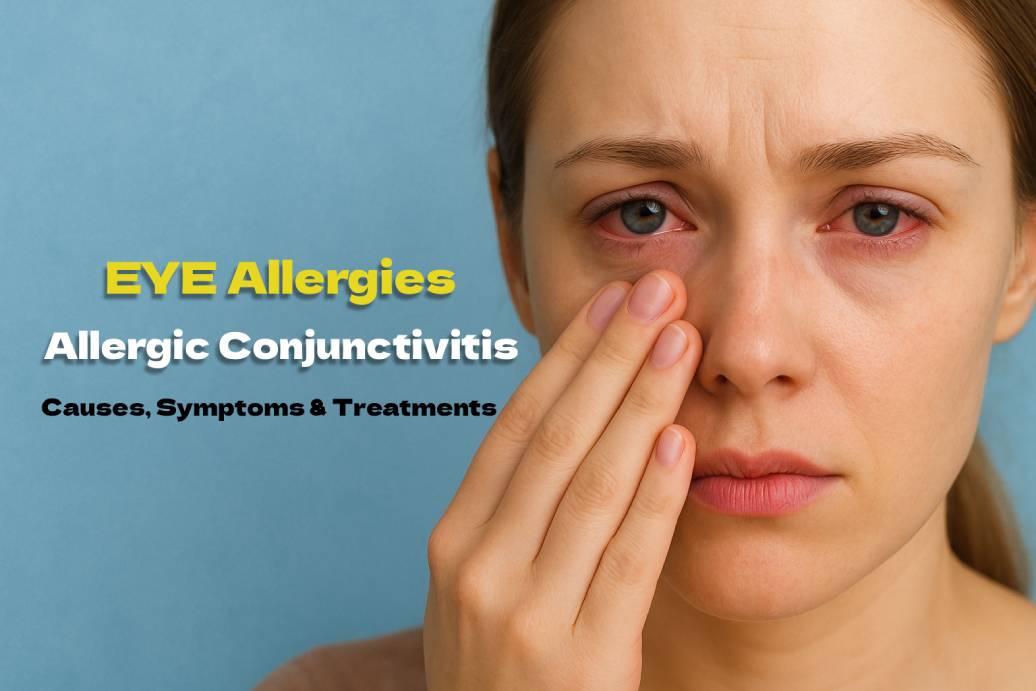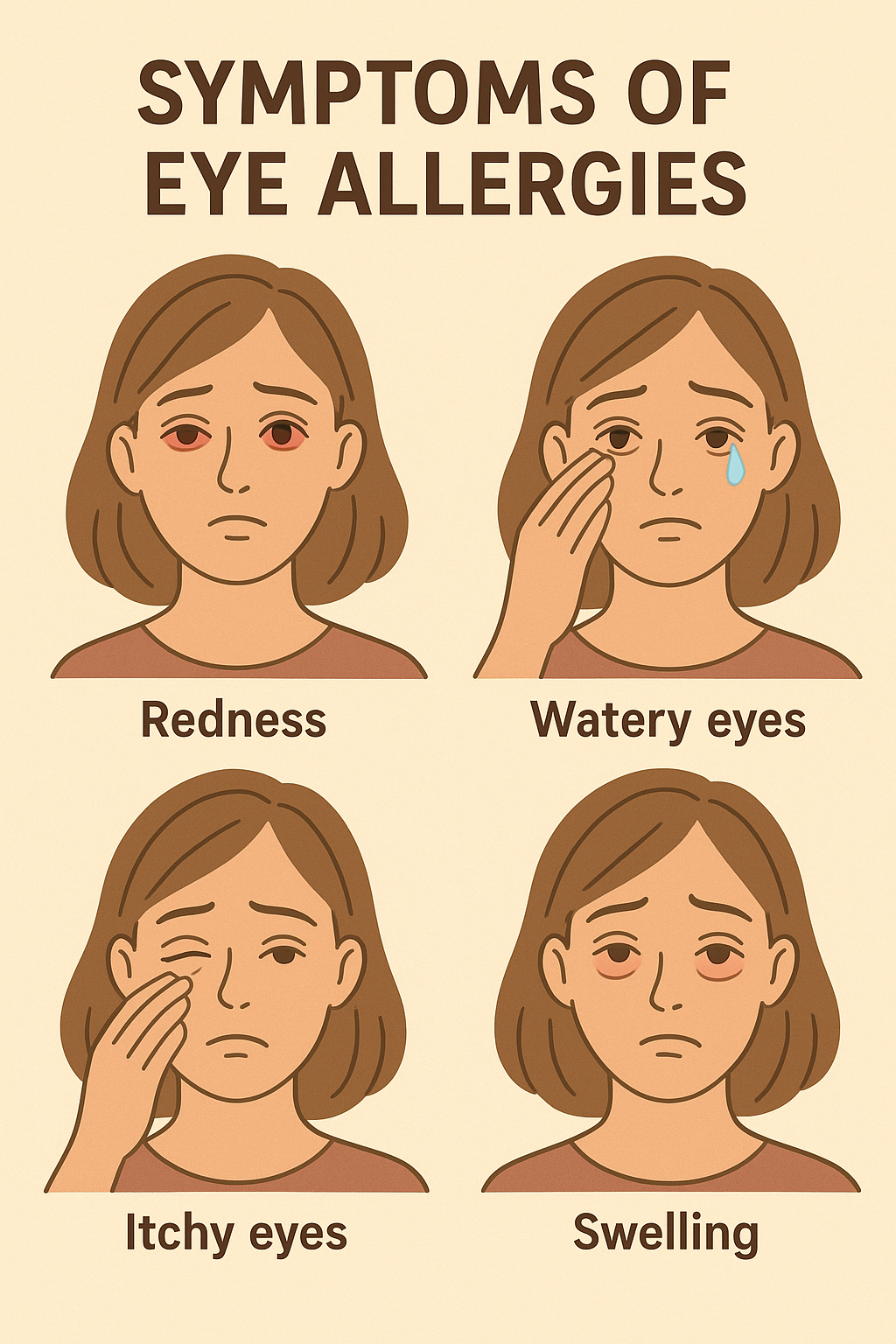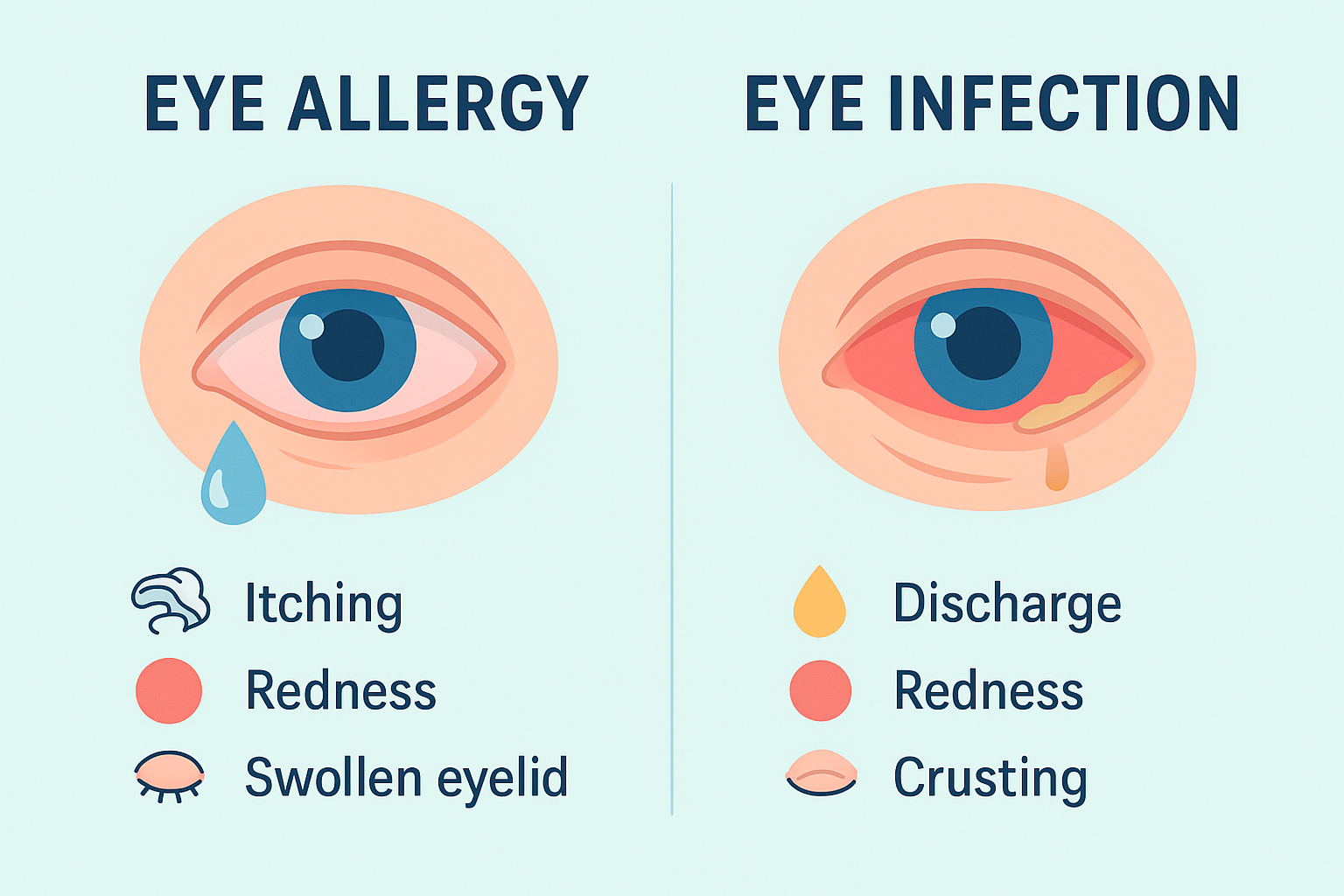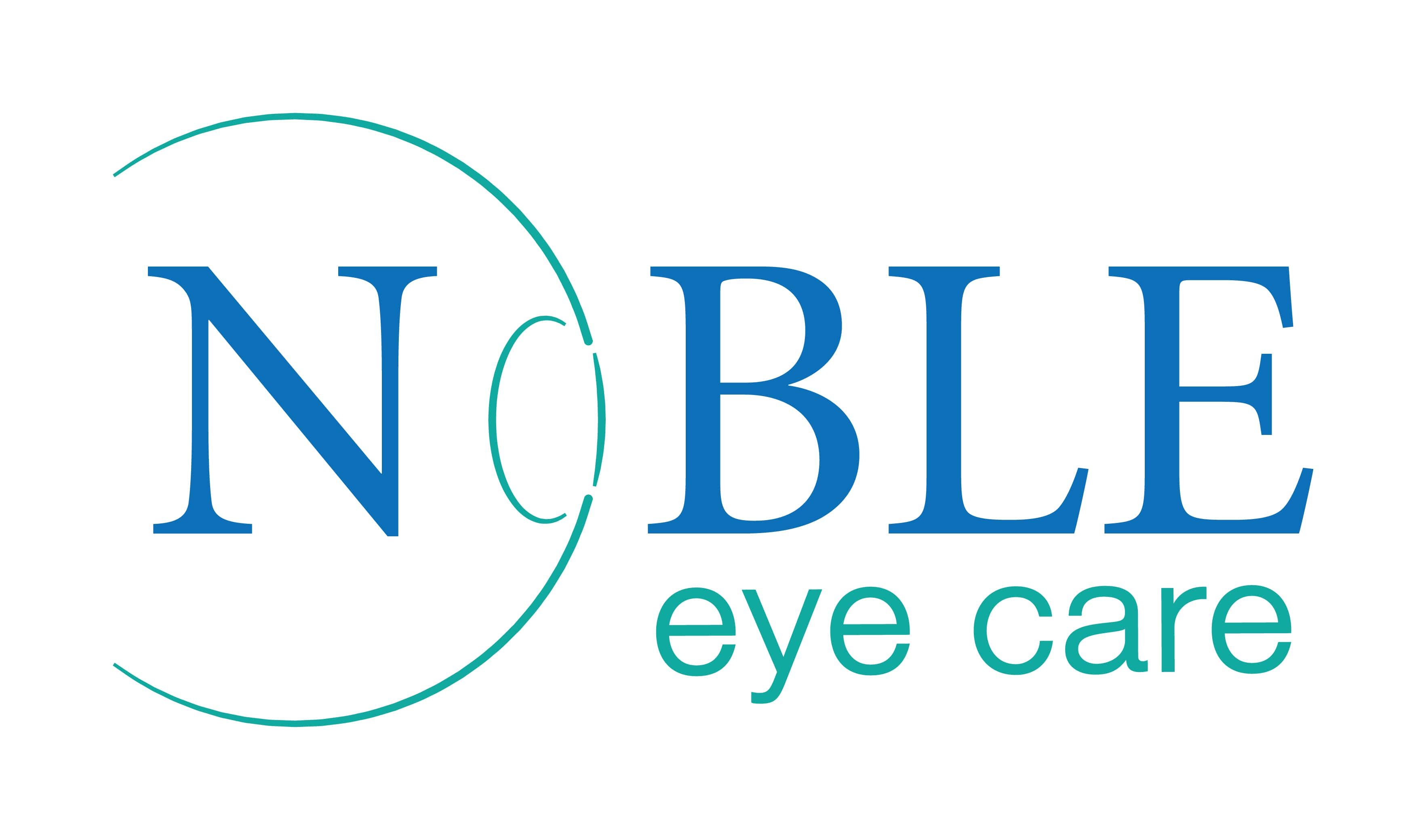The eyes are one of the most sensitive organs of the body and, just like the skin or the respiratory system, the eyes can also develop allergic reactions. Many people often wonder, what is eye allergy and how does it interfere with everyday activities. Eye allergies develop when the eyes respond to allergens like pollen, dust, animal hair, smoke, or even some cosmetics. This allergic response causes the eyes to itch, become red and swollen, and water; all of which can interfere with daily activities.
Eye allergies can be managed effectively if the eye allergy symptoms, eye allergy types, and eye allergy treatment options available are well understood. This article covers the eye allergy reasons, diagnosis, treatment, and when to see an eye specialist.
Table of Contents |
What is Eye Allergy?
So, what is eye allergy? Eye allergy, or allergic conjunctivitis, is a disorder when overreaction of the body’s immune system happens. When an allergen invades the eye, the body responds by releasing histamine and other inflammatory agents, and this causes itchiness, redness, and swelling. While not contagious, eye allergies can considerably affect someone’s quality of life if they go untreated.
Causes of Eye Allergies
Eye allergies occur when your immune system overreacts to certain substances, known as allergens. Some of the most common causes include:
- Pollen: Seasonal allergens from trees, grasses, and weeds can trigger itchy, watery eyes, especially in spring and fall.
- Dust mites: These tiny bugs live in bedding, carpets, and upholstered furniture and can provoke eye allergy symptoms.
- Pet dander: Proteins found in the skin flakes, saliva, or urine of cats, dogs, and other animals can cause eye irritation.
- Mold spores: Indoor and outdoor molds release spores that may lead to allergic reactions in sensitive individuals.
- Certain chemicals and cosmetics: Some makeup products, skincare items, or contact lens solutions can trigger allergic responses in the eyes.
- Smoke and pollution – Partially. Smoke and pollution are more irritants than allergens. They can trigger eye irritation or worsen allergy symptoms, but technically they aren’t allergens themselves.
- Makeup & contact lenses – Partially. Some cosmetics or contact lens solutions can cause contact eye allergies or irritations, but this is usually more of a contact hypersensitivity rather than a true allergy.
Tip: Knowing the causes of eye allergies can help people limit contact and minimize the chance of an allergy attack. Avoiding known allergens and maintaining good eye hygiene can help reduce symptoms and prevent flare-ups.
How Eye Allergies Develop
1. Allergen Exposure:
Allergens (like pollen, dust, or pet dander) come into contact with the surface of your eye or eyelid.
2. Immune System Reaction:
The immune system misinterprets these harmless particles as harmful and produces antibodies to fight them.
3. Histamine Release:
When exposed again, your body releases histamines, natural chemicals that cause inflammation and swelling in the eye tissues.
4. Visible Symptoms:
The eyes become red, watery, itchy, and swollen, often accompanied by burning or excessive tearing. In severe cases, vision may blur temporarily due to swelling or excessive discharge.
Types of Eye Allergies
Eye allergies occur when the immune system reacts to allergens, leading to inflammation, redness, itching, and watering. Depending on the cause and duration, eye allergies are classified into several types:
1. Seasonal Allergic Conjunctivitis (SAC)
- Triggered by seasonal allergens such as pollen from trees, grasses, and weeds.
- Symptoms include itchy, watery, and red eyes, often accompanied by sneezing and nasal congestion.
- Most common during spring and fall.
2. Perennial Allergic Conjunctivitis (PAC)
- Caused by year-round indoor allergens like dust mites, mold spores, and pet dander.
- Symptoms are persistent but usually milder than seasonal allergies.
- Often associated with chronic eye irritation.
3. Vernal Keratoconjunctivitis (VKC)
- A more severe, chronic type of eye allergy, mostly affecting children and young adults.
- Common in warm climates, with symptoms worsening in summer.
- Signs include thick discharge, intense itching, and light sensitivity.
4. Atopic Keratoconjunctivitis (AKC)
- A chronic condition often seen in adults with a history of eczema or atopic dermatitis.
- Symptoms include persistent redness, itching, and swelling, sometimes leading to corneal damage if untreated.
5. Giant Papillary Conjunctivitis (GPC)
- Usually occurs in contact lens wearers, especially with prolonged use or poor lens hygiene.
- Symptoms include itching, mucus discharge, and blurred vision.
- Caused by mechanical irritation and allergic response to proteins deposited on lenses.
6. Drug-Induced or Contact Allergic Conjunctivitis - H3
- Triggered by eye drops, medications, cosmetics, or chemicals.
- Symptoms include redness, swelling, itching, and irritation, usually appearing shortly after exposure.
Tip: Proper diagnosis by an eye specialist is important, as treatment varies depending on the type and severity of the allergy.
Eye Allergy Symptoms
Eye allergies, also known as allergic conjunctivitis, occur when your eyes react to substances such as pollen, pet dander, dust, or mold. When allergens come in contact with the surface of the eye, the immune system releases histamines that trigger inflammation and discomfort. The symptoms can range from mild irritation to severe itching and redness, often affecting daily comfort and vision clarity.
Common Symptoms of Eye Allergies
1. Itching and Irritation
One of the earliest and most noticeable signs of eye allergies is persistent itching. You may feel the urge to rub your eyes frequently, but this can actually make the symptoms worse by releasing more histamines.
2. Redness in the Eyes
Allergic reactions often cause dilated blood vessels, leading to redness in the white part of the eyes (conjunctiva). The redness can be mild or pronounced, depending on the severity of the allergy.
3. Watery Eyes
Excessive tearing or watery discharge is another typical symptom. The body produces more tears in an attempt to flush out the allergen from the eye’s surface.
4. Swollen Eyelids
The release of histamines may cause puffiness or swelling around the eyelids, especially in the morning or after exposure to allergens.
5. Burning Sensation
Many people experience a stinging or burning feeling, which can make it difficult to keep the eyes open for long periods or focus on screens.
6. Light Sensitivity (Photophobia)
Inflamed eyes can become sensitive to light, making bright environments uncomfortable. Wearing sunglasses may help reduce discomfort.
7. Mucous Discharge
Some individuals notice a stringy, white discharge from the eyes, especially upon waking. This is often mistaken for an infection, but in allergic cases, it’s due to irritation rather than bacteria.
8. Blurred Vision
Due to excessive tearing and swelling, you may experience temporary blurred vision, which usually improves once the allergy is managed.
Tips: It is important to know eye allergy vs eye infection. Infections are more likely to be painful and contain a yellow or green discharge and require antibiotics.
Eye Allergy vs Eye Infection
Many people often confuse eye allergies with eye infections because both can cause redness, irritation, and discomfort. However, the underlying causes, symptoms, and treatments for these conditions are quite different. Understanding the differences can help you get the right care promptly.
What is an Eye Infection?
Eye infections, such as bacterial, viral, or fungal conjunctivitis, occur when harmful microorganisms invade the eye. The infection can spread and may require medical treatment to prevent complications.
Common Symptoms of Eye Infections:
- Redness in one or both eyes
- Thick yellow or green discharge
- Crusting of eyelids, especially after sleep
- Pain or a gritty feeling in the eye
- Swelling around the eye
- Blurred vision in some cases
- Often contagious, especially viral and bacterial infections
Key Point: Eye infections can spread from person to person and often require antibiotics, antiviral drops, or other prescribed medications.
Common Differences Between Eye Allergy vs Eye Infection
| Feature | Eye Allergy | Eye Infection |
| Itching | Common and intense | Mild or absent |
| Discharge | Clear, watery | Thick, yellow, or green |
| Redness | Usually in both eyes | One or both eyes |
| Swelling | Mild to moderate | Can be moderate to severe |
| Contagious | No | Often yes (especially viral/bacterial) |
| Onset | Quick after allergen exposure | Gradual or sudden depending on pathogen |
| Seasonal Pattern | Often seasonal (spring/fall) | Not seasonal |
To distinguish between eye allergy and eye infection, contact an eye specialist.
How to Diagnose an Eye Allergy
An eye allergy eye specialist (Ophthalmologist or optometrist) can diagnose allergies by:
- Patients history: Recognising any exposure to allergens and evaluating any seasonal associations.
- Eye examination: Looking at any signs of inflammation or swelling, and assessing the quality of tears.
- Allergy testing: Occasionally performed, allergy tests help in identifying particular triggers.
You should consult an eye allergy eye specialist sooner rather than later in order to rule out infections and provide appropriate eye allergy treatment.
Eye Allergy Treatment
Eye allergy treatment can be as simple as:
1. Avoiding Allergens
The first course of action should be minimising exposure:
- Close windows and doors during high pollen seasons.
- Use air conditioners and dust, mold, and pollen air filters.
- Pet owners should wash hands after handling their animals.
- Use hypoallergenic makeup.
2. Home Remedies
In the case of mild eye allergy symptoms, home care can be very beneficial:
- Use of cold compresses to help the swelling.
- Use of artificial tears to wash allergens from the eye.
- Wash your face and eyelids after you come back in from outdoors.
3. Medications
An eye specialist can prescribe medications which include:
- Eye drops to alleviate discomfort and itching.
- Mast cell stabilizers to prevent the release of histamine and other inflammatory chemicals.
- Decongestant drops to alleviate eye redness.
- Prescribed steroid eye drops, for severe scenarios and under very close supervision.
- When nasal allergies are also part of the picture, oral antihistamines will help.
4. Contact Lens Care
For those with lens-induced allergies,
- Change to daily disposable lenses.
- Improve lens hygiene.
- Contact an eye allergy eye specialist for other options.
How to Cure Eye Allergy
People often ask, how to cure eye allergy? To effectively manage symptoms, one would need to:
- Avoid and identify the triggers.
- Use the right eye medications and eye drops.
- Follow lifestyle modifications, like keeping the house free of dust.
- For severe or chronic scenarios, one will need to keep an eye specialist.
Most people can adopt these strategies, and it will significantly lower the need for long-term medications.
When to See an Eye Specialist
While mild symptoms often improve with allergy medications or avoiding triggers, it’s important to seek medical attention if you experience:
- Persistent redness or pain
- Changes in vision
- Discharge that is yellow or green
- Swelling that worsens over time
An eye specialist can confirm whether it’s an allergy or another condition, such as dry eye or an infection, and recommend the most effective treatment.
Preventive Tips for Eye Allergies
To reduce the chances of flare ups, do the following:
- Use sunglasses when you are outside. This will help you block dust and pollen.
- Pay attention to hygiene and wash your pillowcases and bedsheets often.
- To avoid mold, keep windows closed.
- Refrain from eye rubbing, as it aggravates the issue.
- If contact lenses are worn, keep them clean.
Also Read: Squint (Strabismus) in Children: Causes, Symptoms & Treatment
Conclusion
After discussing what is eye allergy, it is clear that the condition is common and causes discomfort, and the discomfort is manageable. You can keep your eyes healthy if you learn the eye allergy types, understand the eye allergy symptoms, and speak with an eye specialist.
Keep in mind that you must learn how to tell the difference between an eye allergy vs eye infection, as the two differ in treatment. Symptoms can be managed, and discomfort can be lessened with how to cure eye allergy lifestyle changes, in combination with the right eye allergy treatment, though an absolute cure is unlikely.
To prevent complications and maintain your vision, it is best to go to an eye allergy eye specialist to get the right attention when symptoms do not improve.
FAQs: Common Question About Eye Allergies
Q1. What are eye allergies?
Eye allergies, also called allergic conjunctivitis, occur when your eyes react to allergens such as pollen, dust, pet dander, or mold. The immune system overreacts, releasing histamines that cause itching, redness, swelling, and watery eyes.
Q2. What causes eye allergies?
Common triggers include pollen (seasonal), dust mites, pet dander, mold spores, certain cosmetics, contact lens solutions, smoke, and environmental pollution. Identifying triggers helps prevent flare-ups.
Q3. How can I tell the difference between eye allergy and eye infection?
- Eye allergy: Itching, watery eyes, redness, swelling, usually affects both eyes, not contagious.
- Eye infection: Yellow/green discharge, pain, redness, sometimes affects one eye, often contagious.
Q4. What are the types of eye allergies?
- Seasonal Allergic Conjunctivitis (SAC): Triggered by seasonal pollen.
- Perennial Allergic Conjunctivitis (PAC): Caused by year-round indoor allergens like dust or mold.
- Vernal Keratoconjunctivitis (VKC): Chronic, severe, often in children/young adults.
- Atopic Keratoconjunctivitis (AKC): Chronic, usually in adults with eczema or atopic dermatitis.
- Giant Papillary Conjunctivitis (GPC): Common in contact lens wearers.
- Drug/Contact-Induced Allergic Conjunctivitis: Triggered by cosmetics, eye drops, or chemicals.
Q5. What are the common symptoms of eye allergies?
- Itchy, irritated eyes
- Redness in the eyes
- Watery or teary eyes
- Swollen eyelids
- Burning or stinging sensation
- Sensitivity to light
- Mucous discharge
- Temporary blurred vision
Q6. How are eye allergies diagnosed?
An eye specialist may diagnose eye allergies through:
- Reviewing your medical and exposure history
- Conducting a detailed eye examination
- Performing allergy tests to identify specific triggers
Q7. How can eye allergies be treated?
Treatment may include:
- Avoiding allergens
- Home remedies like cold compresses or artificial tears
- Medications such as antihistamine or anti-inflammatory eye drops
- Improved contact lens hygiene for lens-induced allergies
Q8. Can eye allergies be cured permanently?
There is no permanent cure, but symptoms can be effectively managed with proper care, trigger avoidance, and medication. Severe or chronic cases should be monitored by an eye specialist.
Q9. When should I see an eye specialist?
Seek medical attention if you experience:
- Persistent redness or pain
- Changes in vision
- Yellow or green discharge
- Worsening swelling
Q10. How can I prevent eye allergies?
- Use sunglasses outdoors to block allergens
- Wash pillowcases and bedsheets regularly
- Keep windows closed during high pollen or mold seasons
- Avoid rubbing your eyes
- Maintain proper contact lens hygiene



![DigvijayProfile[1]](https://drdigvijaysingh.com/wp-content/uploads/2017/11/DigvijayProfile1.jpg)

Recent Comments